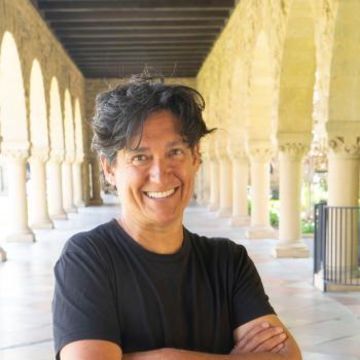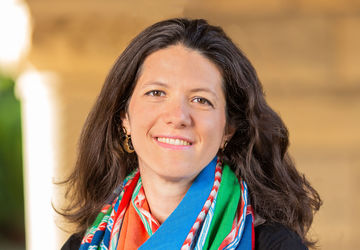Heroism, intimacy, and beliefs about life and death surface in historic research about drowning

While examining historical evidence on drowning deaths and rescues from the 17th to 20th centuries, Lochlann Jain was drawn into questions of not just science and medicine but also heroism, representation, and physical intimacy with strangers. “My project on drowning is turning out to be about a lot of different things,” the professor of anthropology told a recent gathering of the Faculty Research Fellows.
Studying records of deaths in European cities in the 17th and 18th centuries, Jain found drownings comprised a high number of accidental deaths; in London and Venice, the rate was about half. On one single foggy New Year’s Eve night in Amsterdam, 86 people drowned, and only six were saved from the water. People could rarely swim, yet to an extent we no longer see, they were constantly in proximity to water through hygiene, work, bathing, and transport. In a failure of urban planning, lighting was poor, and few walls existed at the banks of canals and rivers. In addition, bystanders had no obligation to intervene. Few possessed strong swimming skills, and local laws often dissuaded rescue, by making pub owners responsible for death expenses, for example, if a victim were brought indoors in a lifesaving attempt.

In the mid-18th century, these practices changed abruptly. Societies organized with the aim of saving the “apparently drowned,” a new advocacy and medical term. “[The term] was interesting to me because it captures kind of this existential mystery of this new body, this unbreathing body pulled from the water, and it draws attention to the kind of apparency of breath and life,” Jain said; “the suddenness of the change in animation, and of course the quandary of how this life might be reinstated.” At that time, most people described death as the moment the soul left the body, so it was remarkable that a few “rogue” believers thought the body could “contain a crucial moment of possibility” in which life could be saved. “This new kind of body comes burdened with possibility and meaning,” Jain said.
Art of the time reflected these changing ideas, including long poems about the glories of resuscitation and paintings depicting the before-and-after of drowning rescue. Jain noted a consistent avoidance of discussing or depicting the acts of rescue and resuscitation, such as dragging bodies from the water, removing clothes, bleeding practices, mouth-to-mouth resuscitation, or the favored remedy of the time: tobacco enemas administered by special machines. “It’s a very curated story about resuscitation and what it was,” Jain noted.
“Intimacy and sex were bound up from the beginning with resuscitation in very interesting ways,” he said. In one case, an enema was delayed because the victim was a woman and several men were present. “There’s this kind of radical contradiction at the core of life-saving between the beauty of the victim, who is inert; the saver as the expert; and the conscious attempts by these societies to create these scenes of emergency.”
In recognition of heroic attempts, such scenes were depicted on expensive metal medallions, minted and offered as prestigious rewards to rescuers by the Royal Humane Society in England. (Heroes of lower social classes sometimes received cash rewards instead.) The medallions typically included “gendered scenes” and images, such as a naked cherub-type figure blowing on a torch as though to revive life, with “Lest some spark remain” engraved in Latin. Like the popular paintings, the medal iconography “constantly negates the intimacy of drowning and resuscitation,” Jain said.
In contrast to this reticence, the bodies of drowning victims in 19th century Paris captured the attention of residents and tourists when the morgue near the river displayed them in street-front windows. Thousands came to view the bodies laid out on marble slabs, somewhat like department store displays. While the original intent was to seek aid in identifying bodies, the number of viewers suggest a different kind of interest.
Moving forward to the 1950s, when artificial respiration became accepted as the preferred method of resuscitation, Jain described a chilling medical study in which volunteers were paralyzed and unable to breathe on their own. Two methods of resuscitation – arm raising and lowering and artificial respiration – were applied by those both trained and untrained in administering interventions. As we now know, artificial respiration proved most effective, even with untrained rescuers. Key to survival is immediate oxygenation, so many advocated extensive training to teach habits and prevent delay in response.
With this project, Jain has been pursuing “forays into experimenting with forms of knowledge” apart from prose; he explained an interest in “how knowledge formation changes a little bit in juxtaposition with forms that are inherited from other modalities,” such as collections and drawings. During research examining historical accounts, archival materials, and art, Jain expanded both his exploration of the topic and his response to the material by creating watercolor paintings and designing cast metal objects.
Jain passed around his own designs for heroic medals in the form of carved resin medallions, intended to be used in casting metal objects, like the awards sometimes conferred on rescuers. Of the project overall, Jain noted, “I don’t know if I want it to be a book with some art pieces in it, or if I want [the art] to be completely separate.” He shared a collection of printed watercolors as well, explaining that for now, the drawings are a way to work through the material.


